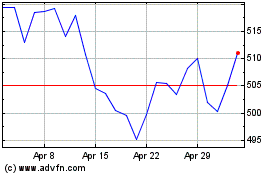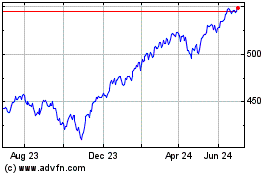Will The S&P 500 Index Enter a Bull Market In July?
July 03 2023 - 6:41AM
Finscreener.org
A recent CNBC “Delivering Alpha”
survey reveals that most Wall Street investors believe the stock
market has entered a new bull market in 2023. Investors also expect
the U.S. economy to remain strong and dodge recession fears this
year.
The survey reportedly collected
opinions from approximately 400 individuals, including chief
investment officers, equity strategists, portfolio managers, and
CNBC contributors who handle money, asking them about market
predictions for Q3 and beyond.
About 61% of those surveyed are
optimistic that the market is entering a new period of growth,
known as a bull market. The remaining 39% anticipate a temporary
market uptick within a general downtrend or a bear market
rally.
Going by the book, some people
have already proclaimed the onset of a new bull market since
the
S&P 500 has risen
20% from its low point in October, a basic criterion for a bull
market. However, some investors donU+02019t consider it the end of
a bear market until the S&P 500 hits a fresh high. The
record closing high for the wider index is 4,796.56, while it
closed on Thursday at 4,396.44.
Despite concerns about rate
increases, a debt ceiling debate, and a series of bank failures,
the market has held its ground this year. The S&P 500 is on
track to finish the yearU+02019s first half with a significant
increase of nearly 15% following four consecutive months of gains.
The tech-heavy Nasdaq Composite has performed even better, soaring by 30% this
year, largely thanks to Wall
StreetU+02019s keen interest in artificial intelligence.
Carol Schleif, the Chief
Investment Officer at the BMO Family Office, suggests that there
are plenty of reasons to be positive about U.S. stocks in the
latter half of 2023, especially since the market is showing more
variety.
Most investors predict the
economy will steer clear of a serious downturn this year, despite
the Federal ReserveU+02019s rapid rate increases. The Fed raised
rates at every meeting from March 2022 onwards, making four
consecutive three-quarter point hikes before taking a breather in
June.
The exceptional conditions of an
unprecedented pandemic, which led to historic fiscal and monetary
responses, may bring about a unique economic downturn.
Jason Draho, the Head of Asset
Allocation Americas at UBS Global Wealth Management, suggests that
we may see rolling recessions affecting different sectors rather
than a typical, all-encompassing recession.
For the rest of 2023, investors
anticipate the best returns from short-term Treasuries and the
S&P 500 and overseas stock markets like Japan, China, and
Europe.
Jobs market and payrolls report
Updates on the job market are due
this week. The Bureau of Labor Statistics (BLS) is set to publish
the Job Openings and Labor Turnover Survey (JOLTS) report on
Thursday. This report will reveal the number of May job openings,
hires, resignations, and layoffs.
Predictions suggest a drop in job
openings to 9.9 million from 10.1 million in April.
ADP (NASDAQ:
ADP), a payroll provider, will also release its
report for June on the same day, showing private sector job growth
expected to be around 180,000.
On Friday, the June nonfarm
payroll report will be out. Experts believe U.S. businesses added
200,000 jobs in June, a slowdown from the unexpected increase of
339,000 in May. The unemployment rate is likely to hold steady at
3.7%. If job creation beats these forecasts, it could support the
Federal ReserveU+02019s argument for additional rate increases to
manage the economy and curb inflation.
The Federal Reserve will make the
minutes from the latest FOMC meeting public on Wednesday. During
this meeting earlier this month, the central bank kept interest
rates unchanged. This came after ten consecutive rate increases
from March of the previous year, aiming to control the highest
inflation in 40 years.
Market traders predict that the
Fed will start raising interest rates again at its policy meeting
in July. According to data from CME Group, there is a 90% chance of
a 25 basis points (0.25%) increase. This could put the key federal
funds rate at 5.25% to 5.5%, the highest in 22 years.
SPDR S&P 500 (AMEX:SPY)
Historical Stock Chart
From Oct 2024 to Nov 2024

SPDR S&P 500 (AMEX:SPY)
Historical Stock Chart
From Nov 2023 to Nov 2024
